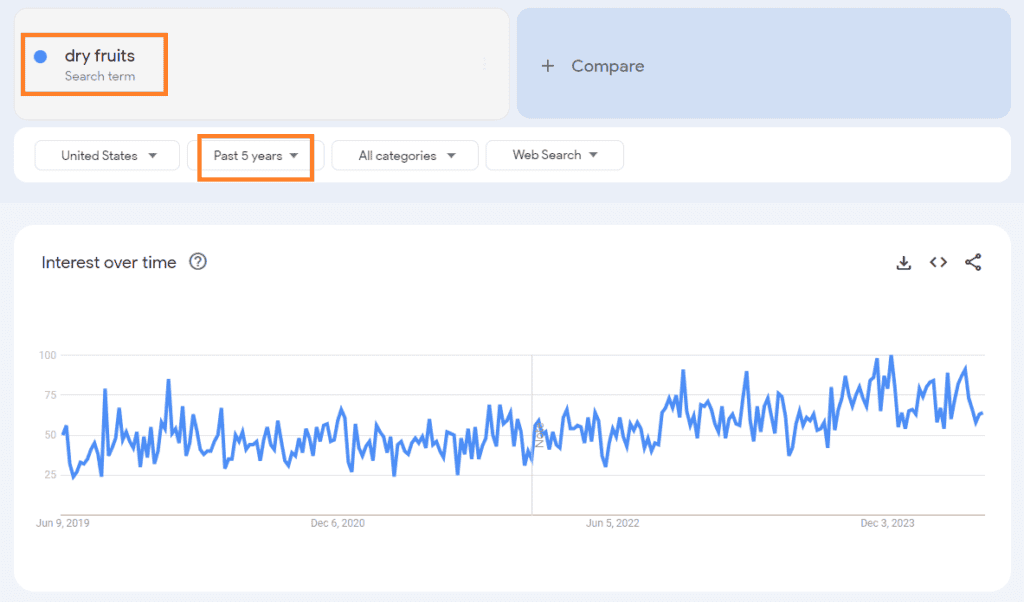Thinking about starting a dry fruit business?
People are looking for snacks that are both tasty and good for them (healthy), so there’s a demand for top-quality dry fruits. In the US, the dry fruit market is growing steadily, which means there’s room for new businesses. The global dry fruit market is big and getting bigger – by 2025, it’s expected to be worth $8.3 billion!
It’s not just about selling stuff. It’s also about helping people make healthy choices.
This blog post will guide you on how to start dry fruit business. You’ll also learn about what are the challenges of starting, profitability and sustainability of dry fruit business.
Whether you’re new to business or you already have one and want to try something new—you’ll get practical advice, easy steps and useful tips to help you create a successful and money-making dry fruit business.
So, let’s get started.
- How to Start Dry Fruit Business: Step by Step
- 1. Research and Planning
- 2. Business Setup
- 3. Production and Quality Control
- 4. Establishing Online Presence
- 5. Customer Engagement and Service
- 6. Financial Management and Growth
- Challenges of Starting a Dry Fruit Business
- Profitability of Dry Fruit Business
- Is Dry Fruit Business Sustainable in the Long Run?
- Conclusion
How to Start Dry Fruit Business: Step by Step
1. Research and Planning
Understand Market Demand
To start, it’s super important to look into the market first (Market Research). You should check out what customers are into by using data analytics and market reports. This can help you figure out what people like to buy and how they like to shop.
Tools like Google Trends and social media can give you updates on what’s hot right now. Some paid tools also provide these trending search terms on Google, Amazon etc.

By knowing this info, you can make products that—match what different groups of people want. For example, millennials might like organic options while baby boomers might want snacks that are good for the heart.
Explore Product Varieties
To reach more customers, it’s important to have a variety of products. You can begin by looking into famous dry fruits like almonds, cashews, and raisins which people always love. But to be different, you might want to think about selling special or uncommon products.
For example, you could have gluten-free or fancy-flavored dry fruits. Stay updated on what people are into health-wise and what they’re eating—so your products match what customers want, like keto-friendly or low-sugar choices.
If you want, you could also mention the benefits of each type of dry fruit (like how almonds are good for your heart) to help customers know more about what they’re buying.
Educational Resources
To keep up in the food business, you should keep learning. Take online courses on how to prepare business plans, read industry publications, and watch webinars to know what’s new(trends and technology).
Go to trade shows and food expos to meet people and understand what customers like. Also, stay on top of safety rules and new packaging ideas so your business follows the rules and stays ahead.
Also consider:
- Try joining food industry groups or forums to connect with other professionals.
- Experiment with different types of dry fruits and flavors to offer unique products.
- Keep an eye on customer feedback to improve your products and services.
2. Business Setup
Legal Requirements for Your Dry Fruit Business
Setting up a solid legal base for your business is super important. You have to register your business, get all the licenses and permits you need, and make sure you follow all the food safety rules from the government.
Legal Requirements of starting a dry fruit business in United States
Starting a dry fruits business in the United States involves several legal requirements and licenses to ensure compliance with federal, state, and local regulations. Here’s a comprehensive list of what you need to consider:
Federal Requirements
- Food Facility Registration: Register your facility with the FDA if you are processing or handling food for consumption in the U.S.
- Prior Notice of Imported Foods: Notify the FDA about any food importation in advance.
- Phytosanitary Certificates: Required for importing dried fruits to certify that the products are pest-free.
- Compliance with FDA Regulations: Adhere to the FDA’s regulations for food safety, labeling, and packaging.
State and Local Government Requirements
- Business License: Obtain a general business license from the city or county where your business will operate.
- Health Department Permit: Required if you are processing food, to ensure compliance with local health codes.
- Sales Tax License: Register for a sales tax permit to collect and remit sales tax.
- Zoning Permits: Ensure your business location is zoned for commercial use and complies with local ordinances.
Types of Licenses and Permits
- Food Handler’s License: For employees involved in the preparation and handling of food.
- Food Manufacturer License: If you are manufacturing and packaging dry fruits.
- USDA Permits: For businesses involved in the importation, transportation, or handling of plant and animal products.
- PACA License: Required by the USDA if you are buying or selling more than 2,000 pounds of fresh or frozen fruits and vegetables on a given day.
Additional Considerations
- Trademark Registration: Protect your brand by registering your trademark with the USPTO.
- Organic Certification: If you plan to sell organic dry fruits, obtain certification from the USDA National Organic Program.
- Food Safety Plan: Develop a food safety plan as part of the FDA’s Food Safety Modernization Act (FSMA) requirements.
- Good Manufacturing Practices (GMP): Follow GMP to ensure your products are consistently produced and controlled according to quality standards.
It’s crucial to seek advice from a legal specialist to understand the particular rules for your (dry fruit) business, as laws can differ greatly by state and the kind of goods you deal with. Also, keeping abreast of any updates in food laws and regulations is—essential to follow the rules and steer clear of legal problems.
Just a reminder, this is a basic overview, and you should—double-check the latest requirements with the relevant government bodies before kicking off your business
Additional Insights:
- Don’t forget about insurance! It’s smart to protect your business and yourself in case something goes wrong.
- Keep an eye on any changes in regulations so you can stay up-to-date and keep your business running smoothly.
Supply Chain Management in Dry Fruit Business
Having a strong supply chain is super important for your dry fruit business to do well. Get top-notch raw materials from good suppliers to keep your products consistent.
Think about using local suppliers – it can save you money on transportation and help out your local community. It’s also smart to make good friends with your suppliers because that can get you better prices, more dependable deliveries, and make sure your products are top-notch.
Insights:
- Keep an eye on the quality of the materials you’re getting from suppliers.
- Check if there are ways to improve your supply chain efficiency for better profits.
3. Production and Quality Control
Processing Methods
Deciding how to process your dry fruits is vital for making good quality products that last long. If you dry them at your own place, make sure to use good machines (high-quality equipment) and have clear steps to follow so every batch turns out the same. If you get someone else to do it, pick a partner who can meet your quality needs and grow with your business.
Extra tip: Make sure to regularly check and adjust your processing methods to keep the quality top-notch!
Essential Equipment for a Dry Fruits Business
Beginning a dry fruits business needs different tools to guarantee smooth processing, quality check, and packing.
Here is a list of vital equipment with details on expenses and factors to think about:
- Commercial Dehydrators: Necessary for removing moisture from fruits to extend their shelf life. Costs can range from $5,000 to $25,000.
- Slicers and Choppers: To cut fruits uniformly, which is important for consistent drying. Prices vary based on capacity and automation level.
- Packaging Machines: For sealing the dried fruits in bags or containers. These can cost between $5,000 and $10,000.
- Labeling Machines: To add your brand and nutritional information to the packaging. These may cost around $10,000 to $40,000.
- Quality Testing Equipment: To ensure your products meet food safety standards.
- Storage Containers: For keeping dried fruits before packaging.
Cost Insights
To kick off a dry fruit business, you’ll need to invest in quality equipment. Recent stats show that the gear and machinery can cost around $20,000 to $50,000. Remember, this amount doesn’t cover other initial expenses such as stock, lease, or advertising.
Things to Consider
- Capacity: Choose equipment based on your business size and growth projections.
- Energy Efficiency: Opt for machines that offer energy savings to reduce long-term operational costs.
- Durability: Invest in high-quality machines that will last longer and require less maintenance.
- Ease of Use: Ensure the equipment is user-friendly and easy to clean.
- Compliance: Verify that the equipment meets all regulatory requirements for food safety.
Remember, even though it might cost a lot at first, picking the correct gear is super important for how well, good, and expandable your dry fruits company can be. It’s like putting money into something now that can help you make more money later by always having great products and keeping your customers happy.
Packaging and Branding
In the dry fruit business, how you package and brand your products is also super important. The way your brand looks and how your products are packaged can really affect what customers think.
Make sure your packaging not only looks good but also keeps your dry fruits fresh. You might want to think about using eco-friendly packaging to attract customers who care about the environment. Your branding should show what your business stands for and connect with the people you’re trying to reach.
4. Establishing Online Presence
E-commerce Platforms
If you’re in the dry fruit business, going online can help you reach more customers. You can set up your own e-commerce website or sell on popular platforms like Amazon or Etsy. Make sure your online store is easy to use, offers secure payment methods, and has detailed product descriptions.
To bring in more customers—work on improving your website’s visibility through SEO techniques. This way, you can grow your business and connect with a wider audience.
Digital Marketing Strategies
To promote your online store, you need a digital marketing plan. Social media helps you connect with customers and build a brand community. SEO boosts your website’s search ranking, making it simpler for customers to discover you.
5. Customer Engagement and Service
Customer Interaction
Having great customer service can make your business stand out. Answer customer questions quickly and make them feel special. Teach customers about your products and how to store them properly. Always listen to feedback to make your stuff better all the time.
Loyalty Programs
Create loyalty programs and promotions to make customers keep coming back. Stay in touch with customers by sending newsletters and using social media. Provide subscription services and gift choices to meet different customer preferences.
6. Financial Management and Growth
Financial Tracking
It’s super important to manage your money well for your business to keep going strong. Make sure you write down every single money move you make and use accounting software like QuickBooks or Xero to help you with your money and business numbers. Look at your financial statements often to find ways to save money and make revenue more.
Business Expansion
When your business gets bigger, think about expanding your product lines or going to new marketplaces to sell. Work with other companies or famous people to get more customers. Always assess the market demand and competition before expanding to ensure the success of your growth strategies.
Challenges of Starting a Dry Fruit Business
Starting a dry fruit business can be tough. Getting good raw materials is hard, especially if importing. Following rules for food safety is important. Building your brand in a tough market takes time and lots of marketing. Keeping track of stock and reducing waste is key for making money. Being ready to change with what customers want and market trends needs new ideas and being flexible.
Profitability of Dry Fruit Business
Is dry fruit business profitable?
This is a common question. The answer is Big Yes.
But, the success of a dry fruit business is all about making money. It depends on things like how much the ingredients (raw materials) cost, how good you are at making them(production efficiency), how you set the prices, and how much people want them (market demand). Usually, you can expect 10-35% profit margin.
Dry fruits can last a long time without going bad, so you won’t lose much by throwing them away. Since more and more people are into healthy snacks and dry fruits can be used in lots of ways, there’s a big chance to make a profit. But you must be smart about spending money, making things efficiently, and keeping an eye on what people want to stay in business for a long time.
Is Dry Fruit Business Sustainable in the Long Run?
The dry fruit sector grows steadily due to health awareness and dry fruits’ snack convenience. Demand rises with plant-based and gluten-free diets trending. Key to lasting success is adapting to consumer changes, innovating products, and upholding quality. A solid brand, loyal customers, and new market exploration aid in business longevity.
Conclusion
Starting a dry fruit business is not easy, but it can be fun and rewarding if you’re ready to work hard. You need to do your homework, set things up right, and find ways to tell people about your business and make them happy. Don’t be scared of problems – they can help you get better.
Keep working on making great products and helping customers, and your dry fruit business can do really well over time. It’s a way to feel good about what you do and earn money too.








